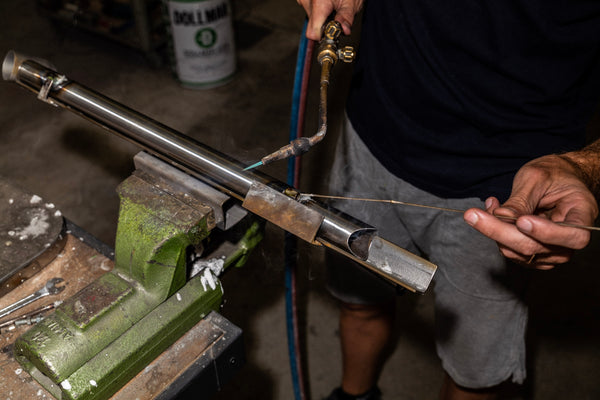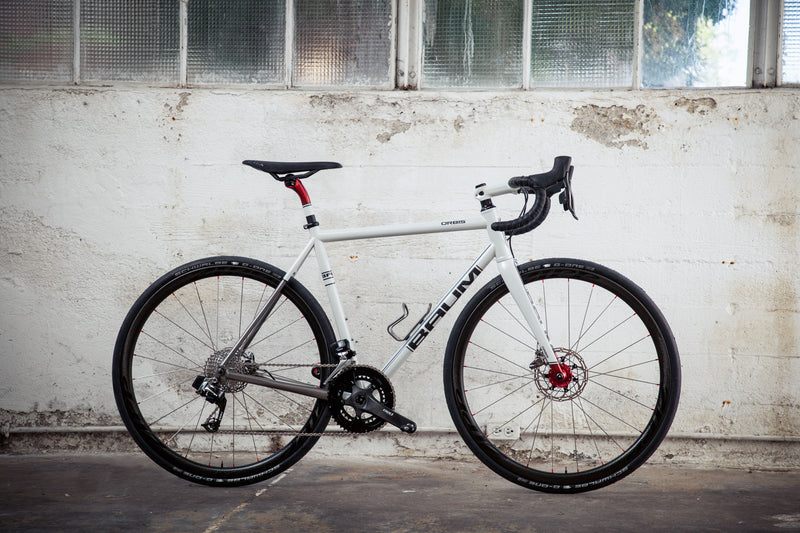Darren Baum is an affable, interesting man. Two hours-affable, according to my watch, once we say our final goodbyes, he with an authoritative nod of the head from his desk in Geelong, Australia and me with a wave, wondering how I'm going to render what he said into words. The problem is, there's just too much. Darren isn't a bike builder; he's a force of nature. The man whose flowing lines, flawless welds and ever-innovative ideas made a lifelong fan of even the great Dario Pegoretti, who saw in Darren a brother in arms and perhaps one of only a handful of people in the whole world who could understand what Darren's work represented: craft, commitment, the freedom of an empty workshop, blind passion, bastard belief and the hope that this night might move the needle, the experience to know it probably wouldn't, and the will to do it anyway.

Perhaps that's where we should start, with the image of a lone artisan burning the midnight oil in an otherwise empty workshop. He looks up for a moment, enjoying the solitude and the chance to frame his thoughts. Suddenly, from a far corner, the phone rings.
Dario: "Hello, is Darren there?"
Darren: "Speaking."
Dario: “This is Dario, Dario Pegoretti. I'm a small frame builder in Italy who makes bikes like you."
What did they talk about? "It got deep and raw and honest very quickly," says Darren, visibly moved by the memory. "He'd just developed his carbon fork and wanted to send me one to see what I thought, but that was just the opening, because he began peppering me with questions." Like what? "Like, ‘When do you get your work done?', When do you have time to paint?' I think he wanted to hear from someone else in his field to see if I'd managed to find a better way to keep all the plates spinning, work and life and so on. I hadn't, but I don't think that mattered as much as talking to a like-minded builder. And the things he knew! It was obvious he'd studied my work from afar, not just skimmed the surface, but dug deep and traced the evolution of dropouts and specific features. Honestly, it was one of the greatest privileges of my life that he rang me what became a handful of times, and we were able to talk as we did. Dario was brilliant.”


Clearly, he thought the same about Darren. And with the now legendary frames that made Baum's name, like the Corretto, Orbis, and Ristretto, a hit list that continues with the newly released Celaris, the rest of the world was quick to catch on, rightly recognizing this independently-minded Australian as a Master in the mould of the greatest the Old World had to offer.
"The Celaris is an expression of where I am in my life right now," explains Darren. "It's what I want to ride, my vision, and I'm stupid and arrogant enough to make it." He pauses, laughing at himself. "Hopefully, other people want to ride it, too."
Darren describes the Celaris as decisive, a bike you understand, and, if you don't, respectfully, "it's not for you." If the Celaris were a car, he says, "It would be a 5-speed manual, a Singer Porsche 911. One with narrower tires so I could head to the Great Ocean Road and really drive it." And while the Porsche wouldn't top the speed sheets, to Darren, it would be more than enough car, fast, comfortable and perfectly composed, ready for whatever lay beyond the next turn. A driver's car? "Exactly. And like all great designs, it's timeless. You like it now; you'll like it in ten years. No outside influence is going to change that."


I pick up the thread and tell Darren about a camera I just acquired, the optical equal to the classic-modern aesthetic of the Celaris. High fidelity, yet the decisions of when to shoot, what to focus on and how to focus are in my hands, analogous to driving with a manual transmission. "A Leica, by any chance?" asks Darren. Yes, I reply. "The Leica Rangefinder was my secondary inspiration for the Celaris," he nods. "It's got a little bit of heft to it. The quality is obvious from the moment you hold it, and you hope you can handle it or learn to. At the same time, there's an awareness that this is something you can pass on to your kids, that it's not static despite its apparent simplicity."
If a Baum frame is highly regarded for the quality of its design and its masterful use of titanium, it is equally celebrated for the exceptionally high quality of its paintwork. So when the Celaris debuted in a gloriously burnt orange, a magnificent hue redolent of race tire rubber or the essence of a lazy afternoon on Lake Como, depending on your mood, longtime Baum watchers breathed a sigh, not of relief but of the simple joy of seeing something done with masterful skill. The color recalls an earlier bike Darren once owned in a similar colorway, back in the days of first-generation Campagnolo 11-speed. It was a deceptively complex burnt orange, but when the bike's cassette separated during a ride, causing the chain to run up and over the gears, he had to repaint it - still orange, but never the same. "Somehow, with the Celaris, I wanted to pay homage to a color that didn't matter to anyone else but me," he laughs. "I wanted to recreate that original burnt orange, as much for the memory of the bike as the color itself."

Inspiration from the past aside, the Celaris exists in a world of integrated everything. And that's where the 'modern' in the bike's modern-classic comes into play, with a neat solution to brake hose management courtesy of an innovative 3D-printed titanium steerer tube insert that allows for the use of a standard bar and stem. It's simple, daring - typically Baum - and pairs perfectly with the bike's other noteworthy front-end detail, a new tapered head tube, billet-machined in-house from a solid bar of 6/4 Ti that, in turn, marries up with a Chris King Dropset 2 headset. "One part of me wanted the bike to have a Campy 12-speed mechanical vibe - classic all the way," Darren admits. "And that might fly now, but how are you going to feel about those external cables in ten years? Would that date the bike? I believed it would, so I had to create an integration solution, not to be modern, but true to a timeless aesthetic."
Arguably, Darren's approach runs counter to the mainstream in this and so many other ways. He doesn't design for sales or a market segment. He designs in service of the product. "It's a privilege that I can be self-indulgent," he says. "In terms of the time I spent and how we make it, my solution is expensive. But I don't have an overlord or someone checking up on me. I can create what I believe is the best solution to the problem, regardless of how many failed attempts and late nights it takes." And there were a few. Darren recalls the first iteration of his cable solution. "I thought it was perfect, yet I found a flaw that could surface if a certain torque was not adhered to during the build process. No matter how small the flaw or unlikely it would make itself known, the engineer in me couldn't let that pass. It killed me to scrap that idea - killed me. In so many ways, I believed it to be brilliant. Yet it wasn't, so I started again."

Thankfully, Darren can smile about it now. "Oh, the ego took a hit, for sure!" he laughs. "It'd be great to make mistakes on someone else's dollar. But I had momentum, so after a night of beating myself up, by the next day, I already had some new ideas, and luckily, it all worked out in the end. It's a process." Is there a lightbulb moment when he finally arrives at a solution? "For me, when it looks right, it's right," he says. "I know that sounds silly, but there's a feeling. If it's simple, obvious, then it's done."
And the beers are on him. "Haha, yes. My team are a great help. We'll sit around watching bike racing after work, having a drink, and kicking around ideas. Their input is invaluable."
These days, Darren's team has become a family affair, with one of his sons, Luca ("I've got two kids of my own, two bonus!"), working in the business, finding time between university engineering classes to learn his dad's craft. "Luca works under our lead manufacturer here, a real dyed-in-the-wool old-school tradesman. It's a great education for him." Did you ever want your kids to be part of the business? "I never asked them," he says." In many ways, they may have even resented the business as something that took me away from family life, so to have Luca here is very special." Darren also credits his other son, William, with building and maintaining the Baum site over the years. Then there's his daughter Téa, currently dashing around the world with an eye for fashion and a desire to work in the industry, and Brad, a skilled carpenter. Whether working in the business or not, Darren is one very proud dad.

He even asks me about myself and my family. For a moment, I'm surprised—usually no-one asks about the interviewer. I answer that I have two daughters, one six months and one three years old. "I'd love to tell you it gets easier," he laughs. "But you just get new challenges. It is beautiful, though."
He could be talking about building bikes.









Back to Journal